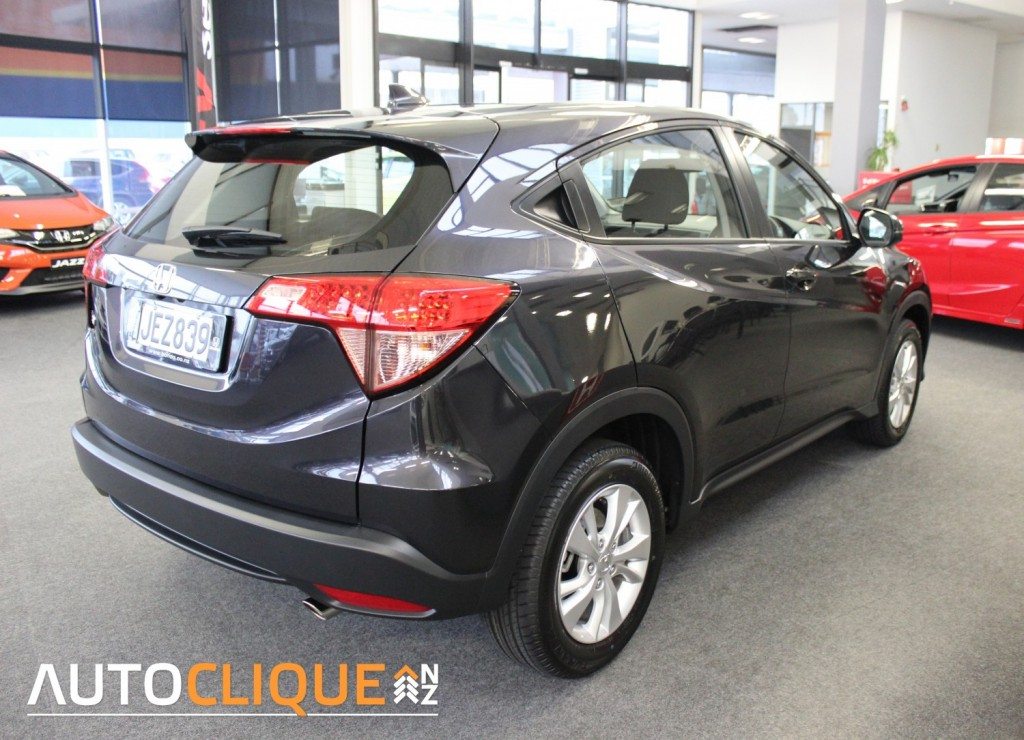A quick trip to the Honda New Zealand website the night before the launch of the new HR-V simply showed a silhouette of the new HR-V, with the word “soon” over it. OK Honda, you have my attention.
In fact the silhouette looked amazing, so it was with my anticipation that I visited Honda in Wellington on launch day today to check the car out in the flesh.
Memories of the old HR-V – something I dubbed The Wedge of Cheese – quickly faded. This new HR-V is like a mini-CRV. In fact, it almost seems better in proportion to the CRV. At one point I was looking at the front of an HR-V with a CRV not far behind – you can tell they are from the same manufacturer quite easily they are so similar in appearance.
There are six models in the HR-V range. It seems Honda have gone all-out in order to cater for every taste.
All models come with the same 1.8L, 105kw i-VTEC engine, that pumps out 172Nm of torque. That torque peaks at a relatively high 4300rpm.
The HR-V S may be the base model, but it’s still well appointed. You get the Earth Dreams CVT automatic, 16” alloys, cruise control, climate control air con, the famous Honda ‘Magic Seat’ system, a 7” touchscreen which can display navigation from your iPhone or Sygic app. Add in Bluetooth, USB and HDMI ports, a 3-angle reversing camera with Dynamic Parking Aid, Hill Start Assist and Vehicle Stability Assist and this base model is quite well kitted out for $32,900.
You can then up-spec the S model to HR-V X which adds front and rear skid plates, and side running boards for a price of $34,200.
The HR-V L takes the S model specs and then adds leather seats, some chrome and stainless steel garnish for $35,900. Gut feeling is that this is the sweet spot in the range.
The next model up is more ‘up-spec’ than the S model. It’s the HR-V Sport which has 17” alloys, LaneWatch camera, a panoramic Sky roof (with tilt/slide), Smart keys with push button start, parking sensors front and rear, auto wipers, paddle shifters, heated front seats, dual-zone air con and some other goodies, for a price of $39,900.
You can then do the same as for the S range, and up-spec the Sport to the HR-V Sport X model which adds in the skid plates and running boards, at $41,200. The top of the range model is the HR-V Sport + which takes the Sport specs and gives it a ‘Front Aero Bumper’, Aero Satin Silver Side Skirts, Rear Aero Bumper, 18” alloys with 225/45/R18 tyres. This top model costs $43,900.
Back to the car. Got to love those rear door handles, my favorite part of the design. Very sexy. The boot is quite spacious, and with the seats folded down gives a large and usable area. The Magic Seats are one of Honda’s success stories, and they really work to make the most of the rear of the car, giving a maximum length of 1.845m flat floor. Interestingly the parcel shelf is just a soft fabric, with a wire frame around the outside. Simple, but it works.
The 864mm long Panoramic SkyRoof of the Sport models is something quite special – you can imagine how much it opens up the cabin when it’s fully retracted.
Apparently there is a new acoustic insulation package that was developed just for the HR-V, and this means just 65dB of cabin noise at 100km/h. A road test will give us the real world test of that claim, and we look forward to it.
It was interesting to see that the front seat passenger has no less than three forward-facing air vents to use.
The LaneWatch camera sounds like a cool gadget. When the left indicator is on, a camera on the left-hand wing mirror displays an 80-degree view of that side of the car, reducing the blind spot on the left side. Great stuff, Honda.
The Sport models are fitted with City Brake Assist, which is designed to help you not crash into the car in front, at speeds below 32km/h.
The Crossover segment is a crowded one. Will Honda be able to break through with a completely new model? Time will tell, but one thing is for sure: Honda is one company that knows how to market its product.
www.drivelife.co.nz is waiting on a test HR-V so we can put it through its paces. Watch this space.
















































